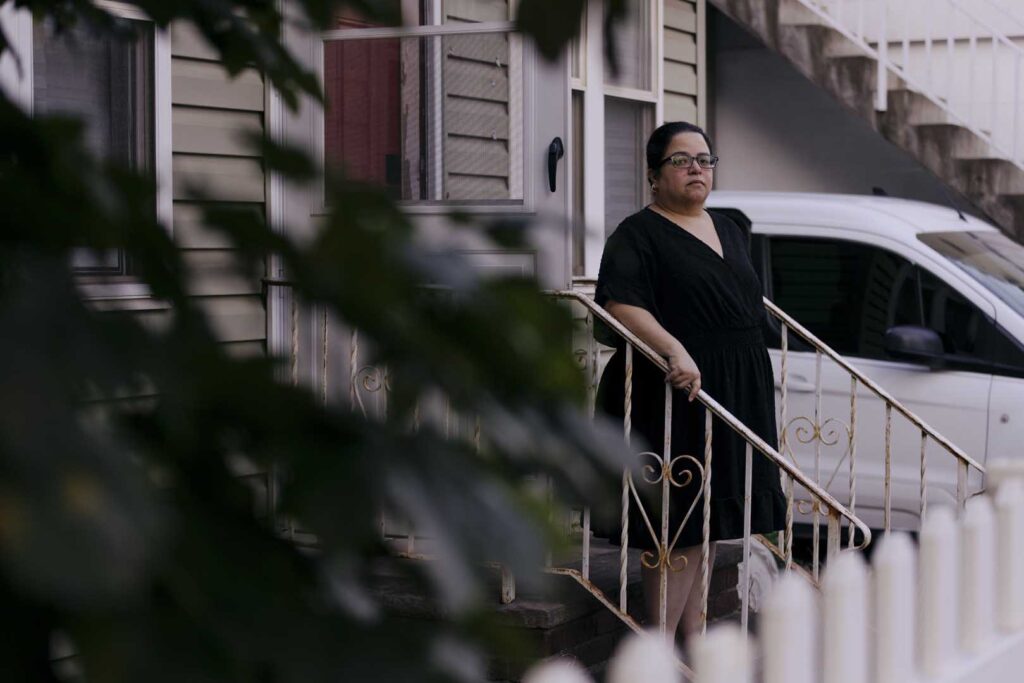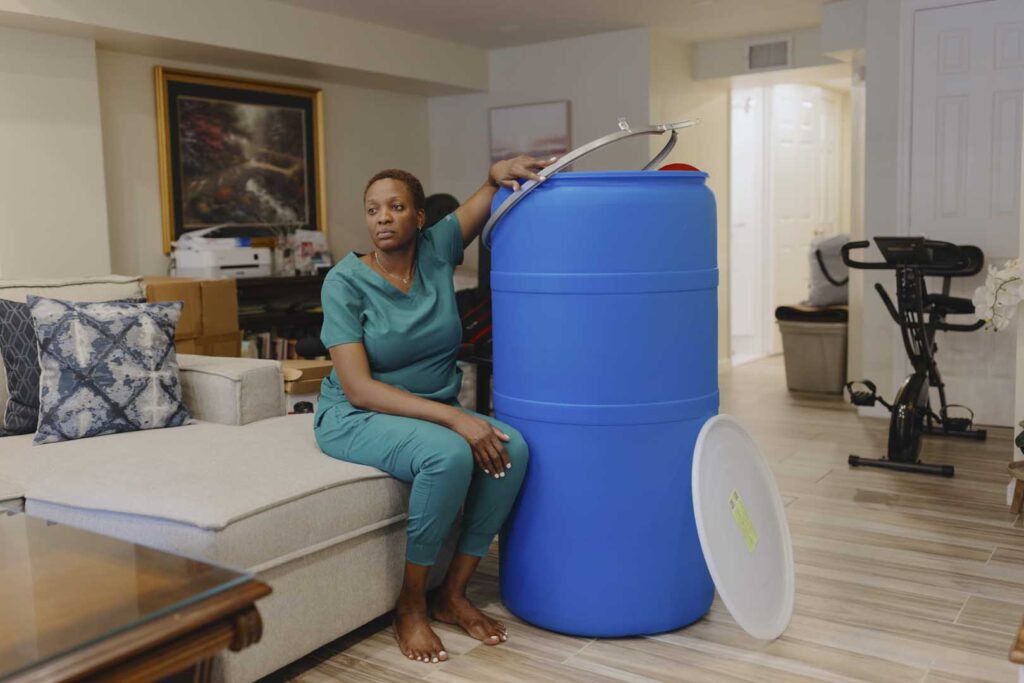NEW YORK — At first sight, Carmen Borrero fell in love with a three-bedroom bungalow built in 1940 with a white picket fence and a driveway, steps away from the beach. She bought it in February for $270,000.
The house is in the New Dorp Beach area of Staten Island and sits in a flood zone on the island’s eastern shore. Borrero, a benefits administrator for a teachers union, said the possibility of storms and flooding was a necessary gamble to be near the sand and surf.
“If you want a house with a good view, close to the water, you know what the deal is,” she said.
Borrero is not alone in accepting that risk.
For many New Yorkers pursuing the American dream of homeownership while navigating the realities of a housing crisis, low-lying areas remain an affordable and popular option despite the mounting effects of climate change — including rising sea levels and more intense rainstorms.
There are thousands of dollars of hidden costs to consider when purchasing a home in a flood-prone area, experts said, from flood insurance to major construction projects. At the same time, there is a growing psychological toll on homeowners who have already relinquished the lower floors of their homes to water and mold, as they continue to pour money into repairs or improvements while waiting for disaster relief or buyout offers.
“I get panic attacks every time it rains,” said Amrita Bhagwandin, who has lived through six floods in Hollis, Queens, spending more than $160,000 on repairs to her house.
But the drive for homeownership remains strong, some real estate experts said. “The demand is insatiable,” said Joseph Tirone Jr., a broker with the real estate firm Compass, who was instrumental in organizing buyouts of damaged homes on Staten Island after Hurricane Sandy walloped much of the borough in 2012. “There’s really not much else people can buy,” he said. “So they buy in flood zones.”
Across the five boroughs, over $3.6 billion worth of one- to three-family homes sold last year were likely to flood before the end of a 30-year mortgage, according to a new report from Rebuild by Design, a climate resiliency nonprofit. That represents roughly 1 of 5 such homes sold in New York City in 2023.
Until 2022, when climbing mortgage rates slowed the real estate market, sales in the city’s flood-risk areas had increased by almost 24% over the preceding eight years, according to further analysis of the Rebuild report.
New Dorp Beach on Staten Island sits practically in the shadow of where hundreds of homes were bought out in the years after Sandy as part of managed retreat programs — when the government buys damaged properties and returns the lots to nature. This history didn’t scare Borrero away.

She is no stranger to hurricanes, having lived in Puerto Rico and Florida. And she loves the beach and the laid-back vibe of her neighborhood. But she is also a realist who intends to elevate her house.
“I’m doing my research to see if FEMA can help,” she said, referring to the Federal Emergency Management Agency, which can assist homeowners whose properties have been damaged by a federally declared disaster (her house flooded during Sandy under different owners). “But if not, I’m going to get a loan,” she said. She estimates that the project would cost somewhere in the broad range between $80,000 and $300,000.
A notable number of new residents of coastal Staten Island are immigrants who have been snapping up properties there and in other low-lying parts of the city because of their affordability, some real estate experts said.
For example, in the New Dorp and Midland Beach areas, where almost three-quarters of residents own the properties they live in, the Chinese immigrant population grew fivefold between 2012 and 2022, from just under 2% of the total population in the area to almost 12%, according to a census analysis by Social Explorer, a demographic data firm. Last year, about 30% of one- to three-family homes sold on Staten Island were in areas at risk of flooding, according to Rebuild.
Some community activists have expressed concern that in cases where there are cultural differences or language barriers, homebuyers may not be fully aware of the risks.
Many Chinese homebuyers are debt-averse, preferring all-cash real estate transactions, said Thomas Yu, executive director of Asian Americans for Equality, a nonprofit organization. Mortgages for homes in high-risk flood zones require flood insurance, he explained, but those who pay in cash could be left unprotected if they skip the expense or aren’t aware of the requirement. “When a disaster strikes, they could be screwed,” he said.
Flood insurance premiums can range from $350 to $10,000 a year, depending on the size and type of home, policy specifics and the flood history and zone of the area, said Monroe Shannon, a program manager for resiliency and insurance at Neighborhood Housing Services of Brooklyn, a nonprofit group.

As the Rebuild report notes, flooding in New York is not limited to surging coastal waters. Stormwater flooding, the result of more extreme rainfall caused by climate change, has become a menace across the city.
It is especially bad in central Queens, where portions of neighborhoods like Hollis and East Flushing were inundated, resulting in several fatalities, when the remnants of Hurricane Ida came through in 2021.
That year, Gina Boehler and Nick Sadiku, who run a dog rescue nonprofit, bought a condo in Middle Village, a quiet middle-class neighborhood in central Queens.
But a few months after they moved in, Ida flooded their basement and destroyed their belongings. After the storm, they paid $3,000 to install check valves, which close and reroute the flow of water when it reaches a certain level, and now run a fan in the basement to prevent mold.
Despite their efforts, the water still creeps in. Last month, a storm caused a “nasty” pileup of water and sewage on their street and in their home, Sadiku said. He cleaned the basement with bleach rather than report the incident to their insurance company, for fear of their rates increasing, he said.
Sadiku, who grew up one neighborhood over from Middle Village, assumed flooding would never be a problem in his new home, and no one told him otherwise during the purchasing process, he said.
A state law that went into effect in March could help protect buyers from such omissions: It requires sellers to disclose a home’s flood history before the sale is final. There is no federal requirement for this kind of disclosure, though slightly more than half of states have flood disclosure laws, according to a recent report by the Natural Resources Defense Council.
New York’s new measure has some critics, however. Amy Chester, managing director of Rebuild, thinks that past flooding should be mentioned earlier in the sales process, like in listings.
On the other side of the issue, some real estate lawyers on Staten Island have introduced a rider waiver that allows sellers to opt out of flood disclosure entirely for a $500 fee, said Tirone, of Compass. The fee is passed on to the buyer as a credit once the sale closes.
For New Yorkers who want to assess their homes’ flood risk, the website floodhelpny.org uses mapping by FEMA to show where flood zones are across the city.
But FEMA mapping does not account for stormwater, said Bernice Rosenzweig, a professor of environmental science at Sarah Lawrence College and a contributor to a new report on flooding in New York City.
“There’s a misperception that if you’re not in one of these mapped flood zones, then you don’t need flood insurance, and that’s really not the case,” she said.
City leaders, aware of the discrepancy, have been updating stormwater maps since 2021. And floodhelpny.org is scheduled to include stormwater risk by early 2025.
But in the end, residents outside high-risk zones must make the decision on their own to buy flood insurance, which is separate from home insurance, experts say.

Stacey-Ann Meikle, who owns a home in Canarsie, Brooklyn, is not in an official high-risk flood zone, so she does not have flood insurance. As a single mother on a dental hygienist’s salary, she cannot afford it anyway, she said.
Her house, blocks away from Jamaica Bay and other bodies of water, is prone to tidal surges and stormwater flooding. As Meikle put it, she has seen “fish and feces” floating in her basement.
She has spent more than $25,000 renovating the basement, but threw in the towel after Ida. Now, she only uses it for storage, with blue plastic barrels at the ready to contain small items and elevate larger ones whenever it floods.
Her rotted-out sewer pipes — the source of the flooding and of an ongoing stench, engineers told her — will require more than $40,000 to fix. Even if she had flood insurance, it is unclear whether it would cover those repairs.
“If I had the money, I’d go and fix it,” said Meikle, who hopes to replace the pipes soon. “I love my home, but I can’t afford it.”
This article originally appeared in The New York Times.




